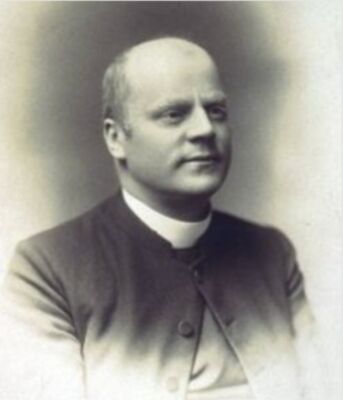John Edward Mercer
Individual, P013

Biography
John Edward Mercer (1857 - 1922)Edward Mercer, as he preferred to be known, was born in Bradford in 1856, the son of an Anglican clergyman. He had an orthodox education at Rossall Grammar School, went up to Lincoln College, Oxford, took his B.A. in 18’79, was ordained deacon in 1880 and priest in 1881. In 1882 he married Josephine Archdall, also the child of a clergyman. Mercer was appointed curate in Northumberland and the couple seemed settled to a conventional clerical career.
However, in late 1883, the Reverend Edward and Josephine Mercer broke the bonds of convention and joined the Rossall School Mission in a depressed area near the heart of industrial Manchester. Six years later the couple faced an even tougher challenge, when Edward was appointed to St. Michael’s Church, Angel Meadow, Manchester. This parish was almost literally a square of 33 acres, or 13.5 hectares, almost in the centre of Manchester. It was a slum area of the worst kind, with a population density seven times and a death rate ten times greater than the rest of the city. Edward and Josephine tackled the brutal proverty and appalling exploitation in housing and work in both Angel Meadow and their subsequent appointment to Gorton, a neighbouring and only slightly less intractable parish. In the space of twelve years their work was so significant that it was regarded as “the beginning of a new epoch” in the area, and as marking a significant distinction between “churchianity and Christianity”.
Edward Mercer’s appointment as Bishop of Tasmania was made in 1902 by the Archbishop of Canterbury on the advice of a committee of English bishops and was the last appointment made under that system. The new bishop’s approach to the Tasmanian Diocese was marked by his determination to press for reforms in social attitudes, in theology, in morals with special emphasis on gambling and liquor, in education and in the community’s awareness of the outside world. In this work the bishop was aided by his wife, Josephine, who was “more concerned with the problems of impoverished pensioners than with … entertainment for the gentry.” She supported him most ably in Tasmania, as she had in Manchester, until her tragic death in 1907.
Bishop Mercer’s uncompromising attitude and his active pursuit of the reforms he propounded, aroused the increasingly bitter opposition of the Tasmanian establishment. This hostility came to a head in 1910 when the bishop helped the Labor Party “on an issue which raised considerable controversy and may have influenced state history.” This was the campaign for establishing Wages Boards. The bishop declared roundly that colonial workers, especially the girls in dressmaking apprenticeships in Hobart, were much worse off than their counterparts in Manchester, and he produced statistics of wages and working hours to prove his assertion.
Bishop Mercer was not only an advocate of Christian Socialism but worked hard to expand and consolidate the work of the Church. One of the most significant events of his episcopate was the opening of St. Wilfrid’s College at Cressy as a college for training candidates for Holy Orders. Another was the formation of the Church of England Men’s Society. Indeed, by 1912 there were ninety-seven clergy in the Diocese compared with sixty-four in 1900.
Early in 1914 Bishop Mercer resigned after eleven years of arduous work, and in failing health. His resignation was received with genuine regret, “even those who had been offended by the Bishop’s strongly expressed views on social problems acknowledged that he had used his great gifts for the good of Church and community.” He returned to England and was appointed Canon Residentiary and de facto Bishop at Chester; later he became Archdeacon of Macclesfield. He died on 28th April 1922.
In St. John’s Church is a window depicting ‘The Annunciation’. There is no inscription. It was given by Bishop Mercer in memory of Josephine, who died at Bishopscourt, Hobart, on 28th March 1907. Also in this church the ecclesiastical arms of the bishop have been carved in the sandstone at the base of the dome. There may have been a connection between him and an old family of Mercer in Co. Kinross, whose arms were used by him. The blazon reads:
Arms:
Per pale on the dexter Az.
a crosier in bend dexter surmounting
a key in bend sinister Or, between four stars of eight points Ar.
The stars representing the principal constellation of the Southern Hemisphere called The Crux Australis, for the See of Tasmania.
On the sinister Or, on a fess
between three crosses pattee Gu in chief and a mullet Az.
in base as many besants.
Crest:
A cross Or.
Motto: Crux christi nostra corona
Related object
Edward Mercer Memorial Window (contributor)Online Sources
https://adb.anu.edu.au/biography/mercer-john-edward-7558
